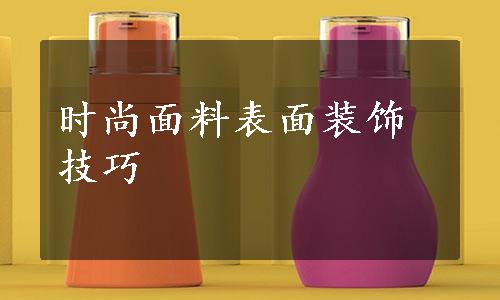
6.3.1 Smocking 抽褶
Smocking is to gather a fabric into some dense and regular puckers. It will work better on a solid fabric(Figure 6-2). Designers need to frst mark the grids or dots in place and then gather the cloth through a single thread.
抽褶法是把面料抽成紧密而又有规律的皱褶(图6-2)。最好用素色面料制作。设计师需要先在恰当的位置画好方格或圆点,再用一根线把布料抽起来。
6.3.2 Cutwork 镂空
Cutwork is to cut away some areas of a fabric according to a certain pattern, and theraw edges are locked by stitches to prevent from fraying(Figure 6-3). Cutwork can also be made with a laser.Laser-cut not only works quickly, but also guarantees the designed patterns to be more precisely “copied” onto the fabric. During this process the raw edges are sealed with heat simultaneously.
镂空就是按照一定的图案剪掉面料上的一部分,再缝锁毛边,防止脱散(图6-3)。镂空也可以用激光制作,激光雕刻不仅迅速,还能保证设计的图案更加准确地“复制”到面料上,同时在此过程中将毛边用高温封住。
Figure 6-2 Smocking(Maker: Zheng Danli)
图6-2 抽褶(制作:郑丹莉)
Figure 6-3 Cutwork(Maker: Li Wenjun)
图6-3 镂空(制作:李文军)
6.3.3 Folding 折叠
A fabric is folded into kinds of shapes just as paper folding(Figure 6-4), and is fastened on a background cloth; this craft can create some three-dimensional effects.
将面料像折纸那样折成各种形状,再固定于底布上(图6-4),这种工艺可以做出一些立体效果。
6.3.4 Burning 燃烧
Most fabrics'fire points are low. If some areas of a fabric are ignited with high temperature, they will be charred. When these areas contrast with the remaining parts of the fabric, it will produce another effect(Figure 6-5).
多数面料的燃点都很低。若将面料上的有些部分用高温点燃的话,会被烧焦。烧焦的部分和剩下的部分形成对比,会产生另外一种效果(图6-5)。
Figure 6-4 Folding(Maker: Lu Yingying)
图6-4 折叠(制作:陆影影)
Figure 6-5 Burning(Maker: Yang Dengshun)
图6-5 燃烧(制作:杨登顺)
6.3.5 Discharge printing 拔染
A bleaching agent is painted onto a fabric to remove some of the color. The removed areas accompanying the remaining colors may create a novelty effect(Figure 6-6).
将漂白剂涂在布料上以去除一些颜色。去除颜色的部分和剩余的颜色结合在一起,可能会产生新奇的效果(图6-6)。
Figure 6-6 Discharge printing(Maker: Wang Lixiao)
图6-6 拔染(制作:王立晓)
6.3.6 Resist dyeing 防染
It refers to various techniques of patterning on a fabric by preventing dye reaching some certain areas of it(Figure 6-7). Batik and tie-dye are the two common techniques.Batik is to paint wax onto a fabric to form a motif, and then dip the fabric into dye liquor. The waxed areas will not take the dye, leaving uncolored motifs against a colored background; meanwhile they can produce natural ice-crack patterns. Tie-dye is to tightly bundle or tie some certain parts of the cloth to prevent dye liquor from permeating.
防染指防止染料染于面料上的某些区域,而形成图案的各种工艺(图6-7)。蜡染和扎染是两种常用的方法。蜡染是用蜡在布料上画上纹样,再浸入染液。着蜡的地方不会被染色,从而在染色的底布上形成白色的花纹,同时产生自然的冰裂纹。扎染是将布料上的特定区域紧紧捆住或打结,以阻止染液的渗透。
Figure 6-7 Resist dyeing(Maker: Students of Qingdao University)
图6-7 防染(制作:青岛大学学生)
6.3.7 Appliqué 嵌花
Appliqué covers a wide number of methods that add pieces of fabrics to a background cloth, usually for decorative purposes. The shapes can be flowers, animals or geometries; two-dimensional or three-dimensional(Figure 6-8). The pieces can be fastened by stitching, or pasting on with special glue.
嵌花的方法有很多,是在底布上添加一些面料裁片,通常是为了装饰。其造型可以是花朵、动物或几何形,平面或者立体(图6-8)。这些裁片可以缝合固定,或者用特制的胶水粘住。
Figure 6-8 Appliqué(Maker: Guan Wanting)
图6-8 嵌花(制作:关婉婷)
6.3.8 Coiling 盘绕
It refers to coiling ropes, threads or cloth strips into some artistic patterns, and then fastening onto a background cloth(Figure 6-9). The fastening methods are similar to appliqué.
将绳子、线或布条盘成艺术图案,固定于底布之上(图6-9)。固定的方法与嵌花类似。
6.3.9 Crocheting 钩编
Crocheting is the method of creating fabrics from threads or ropes. Designers use a crochet needle to interlock the loops together; during this process the designed patterns are also made(Figure 6-10).(www.xing528.com)
钩编是一种用线或绳创造织物的方法。设计师用钩针将线圈套锁在一起,花样也在此过程中钩出(图6-10)。
Figure 6-9 Coiling(Maker: Zhang Qingyu)
图6-9 盘绕(制作:张晴雨)
6.3.10 Embroidering 刺绣
Embroidering is to sew some decorative patterns on a background cloth with threads of various colors(Figure 6-11). The materials, techniques and stitches may differ according to the design. The traditional embroidering craft is time-consuming and needs designers' patience, but nowadays some of the work can be done by a machine. Embroidering can lend fabrics an exquisite effect.
刺绣是在底布上用各种颜色的线缝出装饰图案(图6-11)。其材质、工艺和针法可能根据设计而有所不同。传统的刺绣工艺非常耗时,需要设计师有耐心,但是现在有些工作可以用机器完成。刺绣可以为面料增添精细的效果。
Figure 6-10 Crocheting(Maker: Xu Pei)
图6-10 钩编(制作:徐沛)
Figure 6-11 Embroiderin(Maker: Fan Chunxiao)
图6-11 刺绣(制作:范春晓)
6.3.11 Beading 珠绣
Beading is in essence embroidering with beads; each bead is fastened to the cloth by sewing(Figure 6-12). The beads can be glass beads, pearls, sequins, or made of crystals, plastic, wood, bones, and so on. Beading adds texture to the fabric, lending a delicate and shiny effect to it.
珠绣实质上就是用珠子进行刺绣,每一颗珠子都是用针缝的方法固定在布料上(图6-12)。珠子可以是玻璃珠、珍珠、亮片,或用水晶、塑料、木头、骨头等材料做成。珠绣给织物增添了质感,并赋予其精美、闪亮的效果。
Figure 6-12 Beading(Maker: Li Yutong)
图6-12 珠绣(制作:李禹潼)
6.3.12 Hand Painting 手绘
This is to paint on cloth with special pigments and tools. The methods are similar to painting on paper, but the pigments should not be painted very thick.
这是用特殊的颜料和工具在布料上作画。画法和在纸上画相似,但颜料不能画得太厚。
6.3.13 Quilting 绗缝
Quilting is to sew two or more layers of cloth together with a layer of batting sandwiched between them, in order to create a three-dimensional effect. Sometimes the stitches are some decorative elements as well.
绗缝是将两层或多层的布料缝合在一起的工艺,其中夹了一层棉絮,以创造出立体的效果。有时缝线也是一种装饰元素。
6.3.14 Heat-transfer printing 热转移印花
A piece of cloth and special pre-printed paper are pressed between heated panels, transferring the dye from paper to the cloth by heat(Figure 6-13). This is a low-cost producing process which is suited for short runs.
将布料和一种特制的预先印好图案的纸放在加热板之间,通过加热将染料从纸上转印到布料上(图6-13)。这是一种低成本的生产工艺,适合小批量印染。
Figure 6-13 Heat-transfer printing(Maker: Jiao Youzhu)
图6-13 热转移印花(制作:焦幼竹)
本章小结
■纤维分为天然纤维和化学纤维:天然纤维主要包括植物纤维和动物纤维;化学纤维主要包括再生纤维和合成纤维。
■服装除了用普通面料制作外,还可以用特殊材料制作。
■对服装面料进行表面装饰,可以产生艺术效果。
Exercises 课后练习
1.Create your own “Fabric Library”.创建“面料库”。
Please collect some fabric pieces and paste them on the cardboard. And then write down their names and features correspondingly.
请收集一些面料小样粘在卡纸上,并一一对应写上它们的名称和特点。
2.Please use multiple methods of fabric surface decorations that illustrated above to design your fabric art works, and exchange with your classmates.
请运用上面介绍的多种面料表面装饰方法,来设计你的面料艺术作品,并和你的同学进行交流。
免责声明:以上内容源自网络,版权归原作者所有,如有侵犯您的原创版权请告知,我们将尽快删除相关内容。




